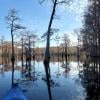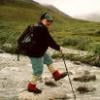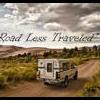cold weather
#1

Posted 24 July 2012 - 03:58 AM
just wondering what temperatures you folks are finding your FWC comfortable at?
we live in the Yukon, Canada (beside Alaska) and would like to find a truck camper that will be comfortable for early spring and winter in the mountains while we are backcountry skiing. i don't think we would camp below -15 degrees celsius (5 farenheit) , but....it may be colder, hard to tell.
hope to hear from some of you!
#2

Posted 24 July 2012 - 12:33 PM
I've used my FWC Hawk (2005) in outside temperatures as low as 0°F and frequently single-digit °F and with the addition of insulation for the soft-sides and with the heater running I was comfortable. The pop-up soft-sides aren't insulated, so they really need help.
Insulation: I use Reflectix (such as this), attached to the the soft-sides with Velcro, mating with the existing OEM Velcro strip at the top. Because this is semi-rigid I have to remove it when I drop the top, but the installation/removal takes only a couple of minutes.
OR you can get the FWC Arctic Pack if you don't mind spending the money. ski3pin did a great home-made version of the Arctic Pack.
Heater: The built-in forced-air furnace is a great way to heat up the camper quickly, BUT: It's loud (they say the fan is quieter in models newer than mine) and the fan consumes a significant amount of electricity from the battery (they say the fan is more energy-efficient in newer models). If your battery's charge isn't high enough the heater won't start because it senses that there's not enough juice for the fan; I've had to start the truck to trick the furnace into thinking there's more juice than there is.
Because the forced-air furnace in mine is loud and consumes battery, I rely almost exclusively on a catalytic propane heater -- the Wave, by Olympian (other brands are available, too). It has no fan so is silent and consumes no electricity -- just propane. I have the Wave 6 model, which is larger than some people here get, but maybe I do more winter camping in cold places.
Catalytic heaters have some downsides: a small amount of venting is required for combustion-efficiency and safety (meaning you have to let a little cold air in and some warm air vents out), and without a fan the heat is not distributed around the cabin as well -- at least, not as quickly, since it's basically a radiant heat source -- things it's "shining on" get hot first.
Comfortable: I should say that for me, in the camper in winter, a "comfortable" temperature may be in the low 60s F or even the high 50s F, 'cause I'm comparing it to what it was like camping in the winter in a tent, and not comparing it to what I would call "comfortable" if I was at home in my house. But I could make it warmer if I ran my Wave 6 on a higher setting -- if I wanted to be home-comfortable.
That's my experience on "cold weather" camping in my pop-up camper.
(BTW: "pixiedust"?
FWC Hawk (2005) on a Ford F250 Supercab, 6.8L V10 gas (2000)
#3

Posted 26 July 2012 - 03:09 PM
#4

Posted 26 July 2012 - 06:36 PM
2003 Ford Ranger FX4 Level II 2013 ATC Bobcat SE "And in the end, it's not the years in your life that count. It's the life in your years."- Abraham Lincoln http://ski3pin.blogspot.com/
#5

Posted 27 July 2012 - 01:16 PM
My wife and I have done more Winter camping than Summer camping. We often camp in the snow. Probably the lowest temperatures we have done so far is about 8 degrees F in British Colombia. We made our own liner that velcro's on the top sides and provides nice extra insulation. The furnace works well but we usually don't run it all night. Thus, when we wake up in the morning the water faucet is frozen and there's frost on things. No big deal. Just a matter of what you are used to.
By the way. We spent time in the Yukon and LOVED it. I even have a Yukon license plate on the front of my truck just for fun (not registered). We were up there for two months in our Landrover and slept in a tent (before we got the 4-Wheel). Lots of great Kayaking.
If you are used to the cold weather, I don't think the 4-Wheel Camper will be a problem for you.
Good luck.
#6

Posted 29 July 2012 - 04:52 AM
#7

Posted 29 July 2012 - 05:20 PM
#8

Posted 29 July 2012 - 07:08 PM
<snip> But compared to my Northface VE25, the FWC is the life of luxury.
2003 Ford Ranger FX4 Level II 2013 ATC Bobcat SE "And in the end, it's not the years in your life that count. It's the life in your years."- Abraham Lincoln http://ski3pin.blogspot.com/
#9

Posted 12 November 2012 - 10:37 PM
Welcome to WTW, pixiedust!
I've used my FWC Hawk (2005) in outside temperatures as low as 0°F and frequently single-digit °F and with the addition of insulation for the soft-sides and with the heater running I was comfortable. The pop-up soft-sides aren't insulated, so they really need help.
Insulation: I use Reflectix (such as this), attached to the the soft-sides with Velcro, mating with the existing OEM Velcro strip at the top. Because this is semi-rigid I have to remove it when I drop the top, but the installation/removal takes only a couple of minutes.
OR you can get the FWC Arctic Pack if you don't mind spending the money. ski3pin did a great home-made version of the Arctic Pack.
Heater: The built-in forced-air furnace is a great way to heat up the camper quickly, BUT: It's loud (they say the fan is quieter in models newer than mine) and the fan consumes a significant amount of electricity from the battery (they say the fan is more energy-efficient in newer models). If your battery's charge isn't high enough the heater won't start because it senses that there's not enough juice for the fan; I've had to start the truck to trick the furnace into thinking there's more juice than there is.
Because the forced-air furnace in mine is loud and consumes battery, I rely almost exclusively on a catalytic propane heater -- the Wave, by Olympian (other brands are available, too). It has no fan so is silent and consumes no electricity -- just propane. I have the Wave 6 model, which is larger than some people here get, but maybe I do more winter camping in cold places.
Catalytic heaters have some downsides: a small amount of venting is required for combustion-efficiency and safety (meaning you have to let a little cold air in and some warm air vents out), and without a fan the heat is not distributed around the cabin as well -- at least, not as quickly, since it's basically a radiant heat source -- things it's "shining on" get hot first.
Comfortable: I should say that for me, in the camper in winter, a "comfortable" temperature may be in the low 60s F or even the high 50s F, 'cause I'm comparing it to what it was like camping in the winter in a tent, and not comparing it to what I would call "comfortable" if I was at home in my house. But I could make it warmer if I ran my Wave 6 on a higher setting -- if I wanted to be home-comfortable.
That's my experience on "cold weather" camping in my pop-up camper.
(BTW: "pixiedust"?)
What about water in your tank etc. Does it ever freeze?
#10

Posted 13 November 2012 - 03:44 PM
That is an excellent question, especially if the question includes the whole water system, beyond the tank.What about water in your tank etc. Does it ever freeze?
Unfortunately, it's a question I have, too -- so unfortunately I don't have much of an answer.
OK: Back when my water pump still worked, so back when I actually used the camper's water system, I assumed that the system would freeze during cold-winter camping because I didn't keep it very warm in the camper because the furnace fan drew too much power and was too loud. During winter camping -- which I did/do in places where it can get down to single-digits-°F -- I carried water in a 5-gallon water carboy with a spigot to supply my water needs.
Then, maybe because I didn't drain the system properly before winter -- or maybe for a reason that has nothing to do with freezing -- my pump stopped pumping, and I haven't fixed it yet and always use a portable water carboy.
Kinda embarrassing to admit, but there it is.
FWC Hawk (2005) on a Ford F250 Supercab, 6.8L V10 gas (2000)
0 user(s) are reading this topic
0 members, 0 guests, 0 anonymous users


















